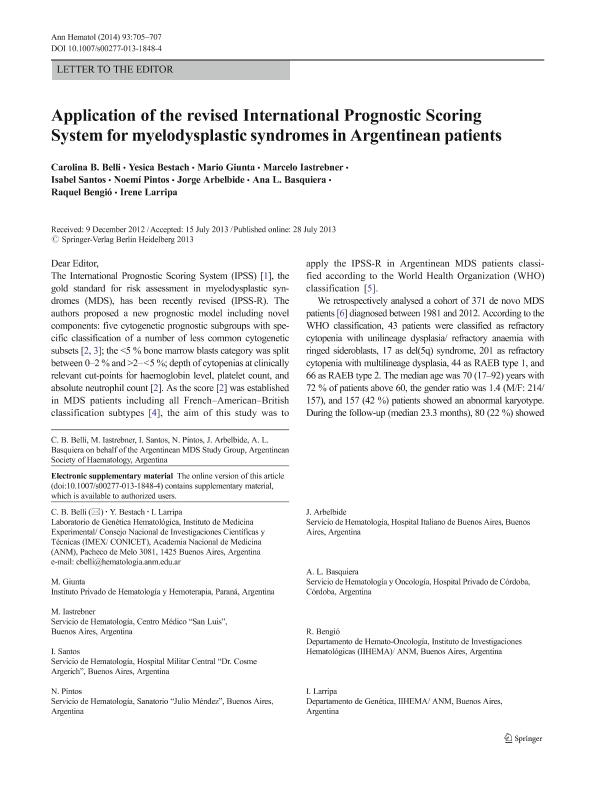Artículo
Application of the revised International Prognostic Scoring System for myelodysplastic syndromes in Argentinean patients
Belli, Carolina Bárbara ; Bestach, Yesica Soledad
; Bestach, Yesica Soledad ; Giunta, Mario; Iastrebner, Marcelo; Santos, Isabel; Pintos, Noemi; Arbelbide, Jorge; Basquiera, Ana L.; Bengió, Raquel; Larripa, Irene Beatriz
; Giunta, Mario; Iastrebner, Marcelo; Santos, Isabel; Pintos, Noemi; Arbelbide, Jorge; Basquiera, Ana L.; Bengió, Raquel; Larripa, Irene Beatriz
 ; Bestach, Yesica Soledad
; Bestach, Yesica Soledad ; Giunta, Mario; Iastrebner, Marcelo; Santos, Isabel; Pintos, Noemi; Arbelbide, Jorge; Basquiera, Ana L.; Bengió, Raquel; Larripa, Irene Beatriz
; Giunta, Mario; Iastrebner, Marcelo; Santos, Isabel; Pintos, Noemi; Arbelbide, Jorge; Basquiera, Ana L.; Bengió, Raquel; Larripa, Irene Beatriz
Fecha de publicación:
04/2014
Editorial:
Springer
Revista:
Annals Of Hematology
ISSN:
0939-5555
Idioma:
Inglés
Tipo de recurso:
Artículo publicado
Clasificación temática:
Resumen
The International Prognostic Scoring System (IPSS) [1], the gold standard for risk assessment in Myelodysplastic syndromes (MDS), has been recently revised (IPSS-R). The authors proposed a new prognostic model including novel components: five cytogenetic prognostic subgroups with specific classification of a number of less common cytogenetic subsets [2-3]; the <5% bone marrow blasts category was split between 0-2% and >2-<5%; depth of cytopenias at clinically relevant cut-points for haemoglobin level, platelet count and absolute neutrophil count [2]. As the score [2] was established in MDS patients including all French-American-British classification subtypes [4], the aim of this study was to apply the IPSS-R in Argentinean MDS patients classified according to the World Health Organization (WHO) classification [5]. We retrospectively analysed a cohort of 371 de novo MDS patients [6] diagnosed between 1981 and 2012. According to the WHO classification, 43 patients were classified as refractory cytopenia with unilineage dysplasia/ refractory anaemia with ringed sideroblasts, 17 as del(5q) syndrome, 201 as refractory cytopenia with multilineage dysplasia, 44 as RAEB type 1, and 66 as RAEB type 2. The median age was 70 (17-92) years with 72% of patients above 60, the gender ratio was 1.4 (M/F: 214/157), and 157 (42%) patients showed an abnormal karyotype. During the follow-up (median 23.3 months), 80 (22%) showed leukemic progression and 161 (43%) died (median overall survival: 55.5 months). Studied variables (gender and WHO classification, % bone marrow blast, cytogenetic risk category, and depth of cytopenias according to the IPSS-R [2]), and the IPSS [1], IPSS-R (Fig. 1a-b), and IPSS-R adjusted by age (Fig. 1c) [2] systems showed statistical differences for predicting both overall survival and leukemic evolution (see supplementary information). Patients were classified by the IPSS-R as very-low (23%), low (40%), intermediate (15%), high (14%), and very-high risk (9%), with median survival of 125, 62, 44, 19 and 15 months (Fig. 1a), and time to leukemic evolution (25%) of >150, 131, 51, 6, and 5 months, respectively (Fig. 1b). The proposed IPSS-R defines a new intermediate risk group mainly composed by patients from the intermediate-1 IPSS risk category (84%, 47/56) and allowed us to identify 7% (11/150) of patients that were shifted from the intermediate-1 risk group into the high IPSS-R risk group. Although limit age of 60 years did not show statistical differences for predicting survival, our results confirm that younger good risk patients have significantly better prognosis than elderly counterparts (very low/ low risk patients: 125 vs. 64 months, p=0.014), while the age at diagnosis has no impact on disease outcome for higher risk patients [1-2, 7-8]. The proposed formula for an age-adjusted categorization [2] helped us to identify 19% (28/147) of short surviving patients among low risk IPSS-R patients with a median survival of 34 months (Fig. 1d). These patients showed, among relevant parameters, a gender ratio M/F of 3.0, a median age of 81 years, 2.5% of BM blasts, 9.1g/dL of haemoglobin level, 12 (43%) presented an abnormal karyotype and 17 died, including 6 patients with previous leukemic progression. It can be concluded that the IPSS-R system is simple to use since includes accessible variables showing a good reproducibility, effectiveness in predicting clinical outcome, and a refinement of the intermediate risk category in our WHO classified series.
Palabras clave:
Myelodysplastic Syndromes
,
Ipss-R
,
Risk
,
Prognostic
Archivos asociados
Licencia
Identificadores
Colecciones
Articulos(IMEX)
Articulos de INST.DE MEDICINA EXPERIMENTAL
Articulos de INST.DE MEDICINA EXPERIMENTAL
Citación
Belli, Carolina Bárbara; Bestach, Yesica Soledad; Giunta, Mario; Iastrebner, Marcelo; Santos, Isabel; et al.; Application of the revised International Prognostic Scoring System for myelodysplastic syndromes in Argentinean patients; Springer; Annals Of Hematology; 93; 4; 4-2014; 705-707
Compartir
Altmétricas



